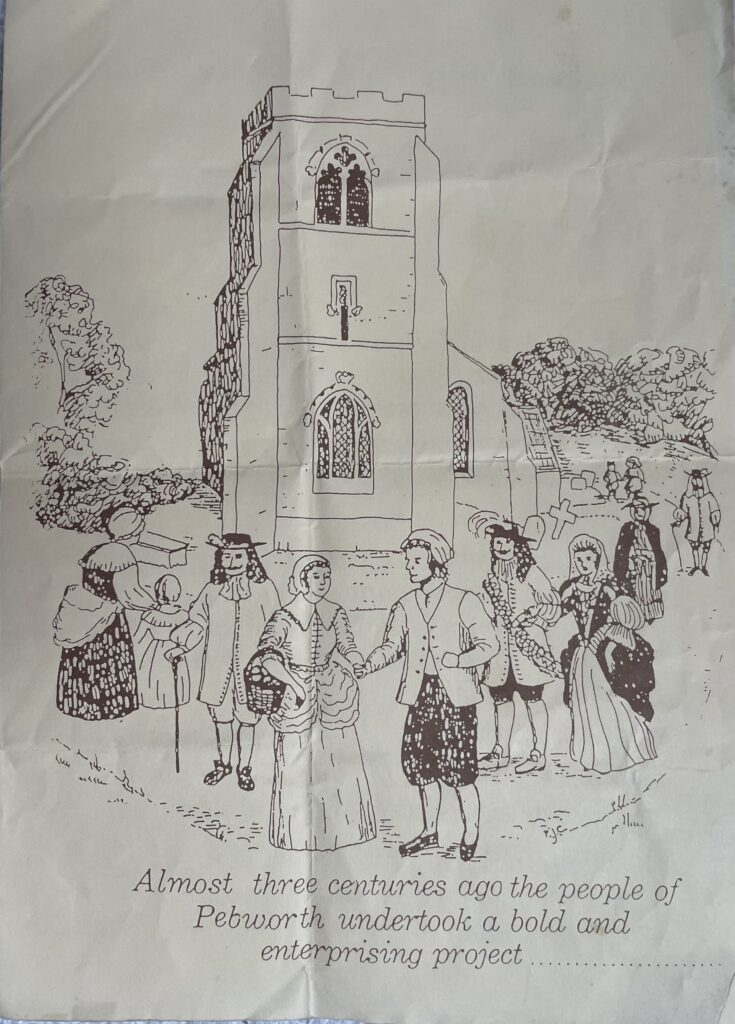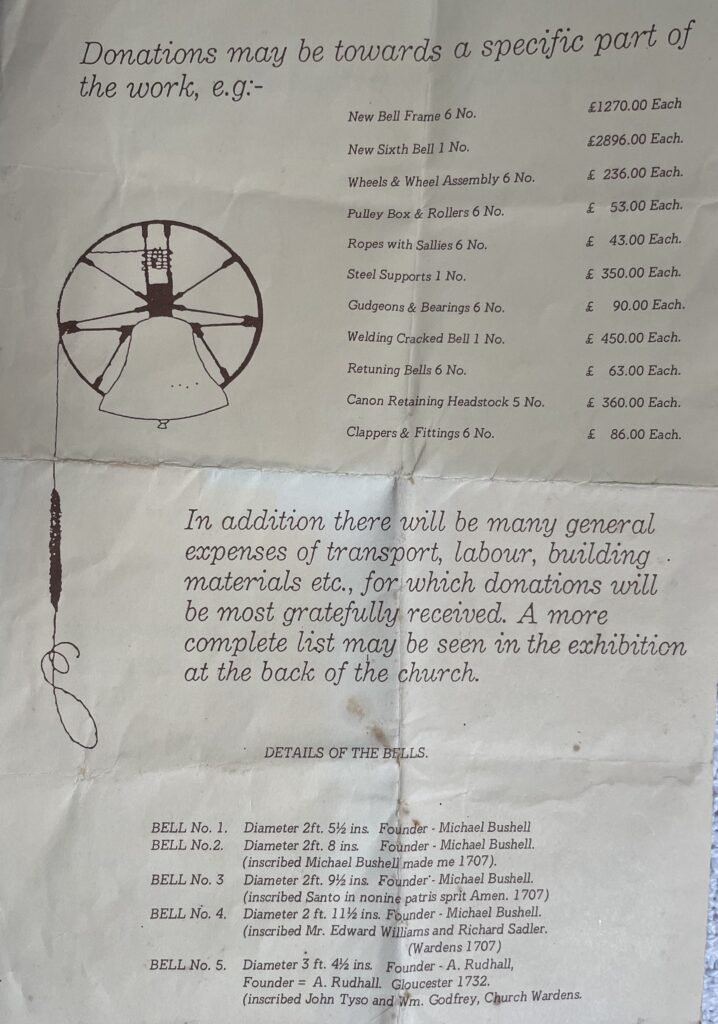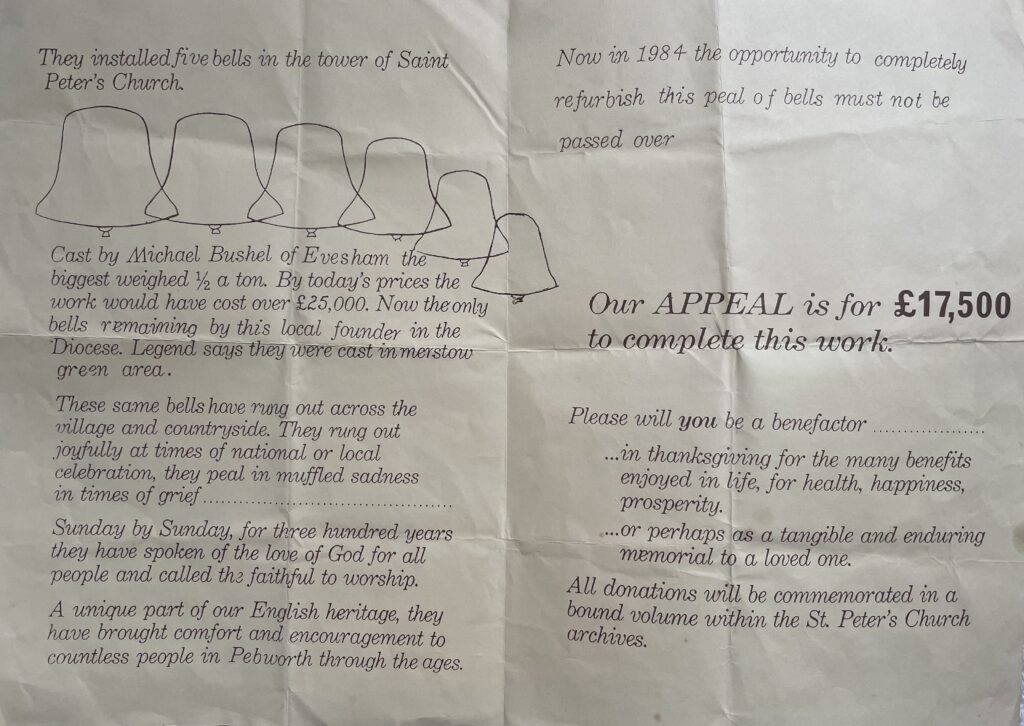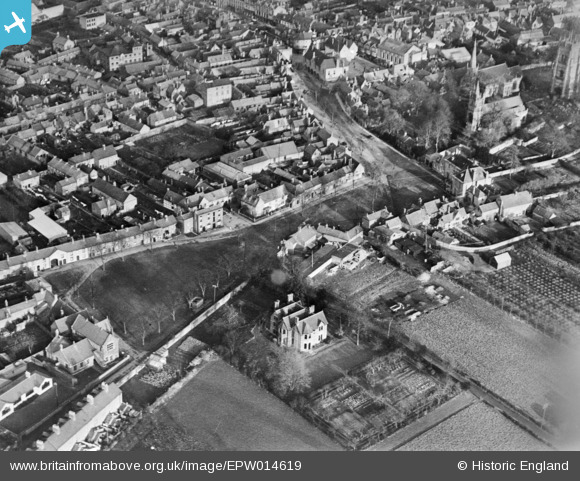From the Archives....
In 1987, the village completed a major project to restore and rehang and the bells… This was the start of three separate projects which would span the next 15 years and see the bells finally augmented to 10.
The article below is copied from a booklet produced on 1987 for that first restoration project and was written by David Baker for the Restoration Committee and includes excepts from the parish record of 1707-8 which documents the original work which saw Michael Bushell install the original ring of 5 bells.
The booklet was beautifully produced with lots of photos. However, these printed photos do not scan or reproduce very well, so we have replaced many of the more general ones with current up to date versions, only keeping ones which include content of historical interest which could not be replaced.
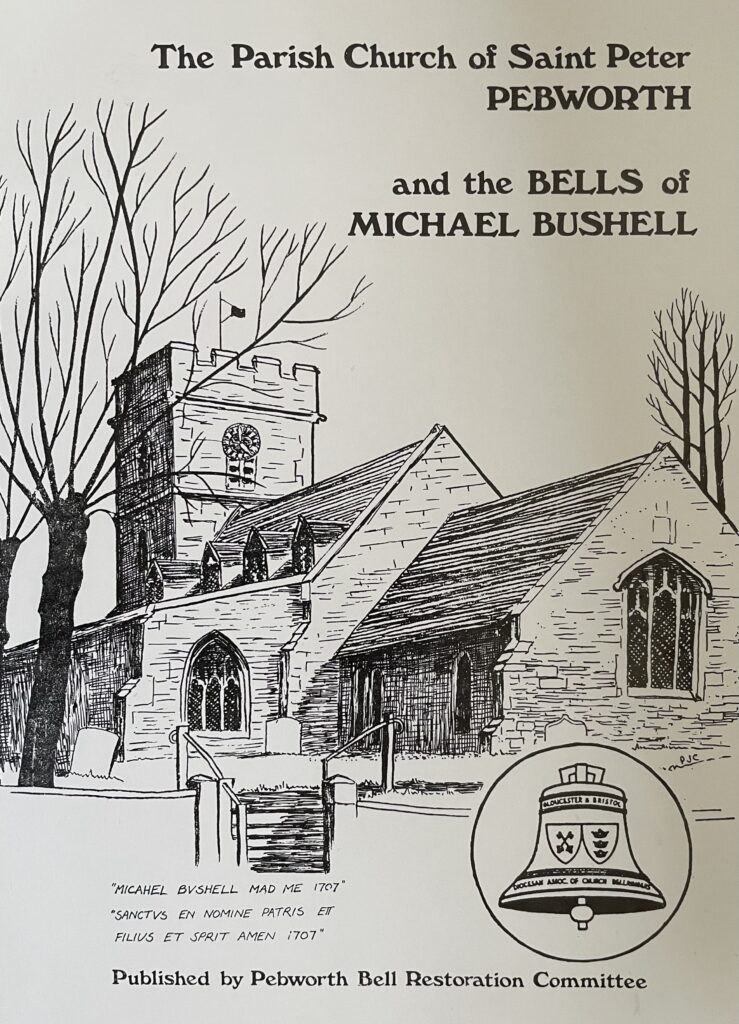
The Silent Bells of Pebworth
Two years ago after taking up residence in Pebworth at “The Knoll” one of the closest houses to the church, I was asked to join the P.C.C. On the retirement of the late Mr. Frederick Hands in 1983 (who I didn’t know at the time was one of the last Pebworth Bell ringers), I succeeded him as Church Warden. Being connected with the construction industry I became interested in the fabric of the church. At the quinquennial inspection by the architects in 1984 the bells were reported as ‘out of order’ and not to be rung. I then started to notice when talking to people around the village the question of the church bells was repeatedly mentioned, people were asking about them and showing great interest in them. It was at this stage that I decided to look into the possibility of the repair and at the next P.C.C. meeting the question was raised.
Are the Bells part of the fabric of the church? If so why are we not repairing these Bells like we repair any other part of the fabric that is in need of repair? The answer was Yes we should but look at the cost. If it was the heating boiler that had failed we would still repair it despite the cost. The bells dating back to 1707 were of more historic interest than a boiler or such things.
It was agreed that the Bells should be repaired and that an appeal should be launched and a sub-committee formed to oversee the Bell Appeal.
The Bells belong to the village of Pebworth ,they were put into the tower by the villagers of that day. It is our duty as custodians of the village of Pebworth to pass onto the next generation the Bells of St. Peter’s in good working order so that they may ring out God’s Loveto the people of Pebworth.
Many thanks to you for helping Pebworth Bell Appeal and to all the many helpers who have given their time and talents to this end.
Eric Jackson
Chairman
The Church of Saint Peter, Pebworth
Pebworth, best known perhaps from Shakespeare’s jingle “Piping Pebworth”, is mentioned in the Domesday Book of 1086. Pebworde values at 90/-, though it had formally been worth £7. Pebworth derived its name from an early Saxon owner, and it was once Pebba’s worth (estate).
The Church, standing on a mound above the village is dedicated to St Peter. This ancient building, dating back to the 13th century, has been enlarged and restored over the years. The church is entered by the north door which is a fine specimen of medieval work, having 15th century iron work and appears to hang on its original hinges.
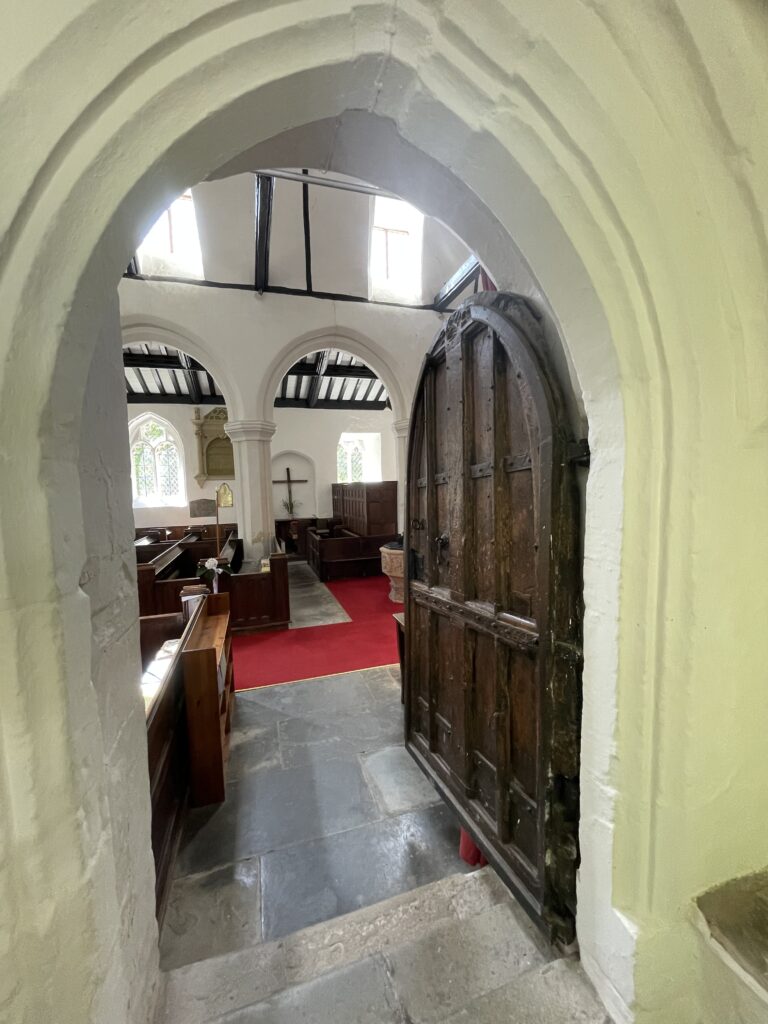
The Font and Nave
The font is 15th century and octagonal in shape. Its bas is unusual in that the priest’s step (now much worn) is an integral part of the base. The only other example of this in Gloucestershire is at Wormington some twelve miles distant.
The nave built in Perpendicular style with barrel roof is 15th century, but the south side aisle was added in the 16th century, still in the perpendicular style. In the Will of one Edmund Martin, the south aisle is called “The new Ile”. The Will is dated 1528.
The dormer windows over the south aisle are unusual and were erected in the 29th century.
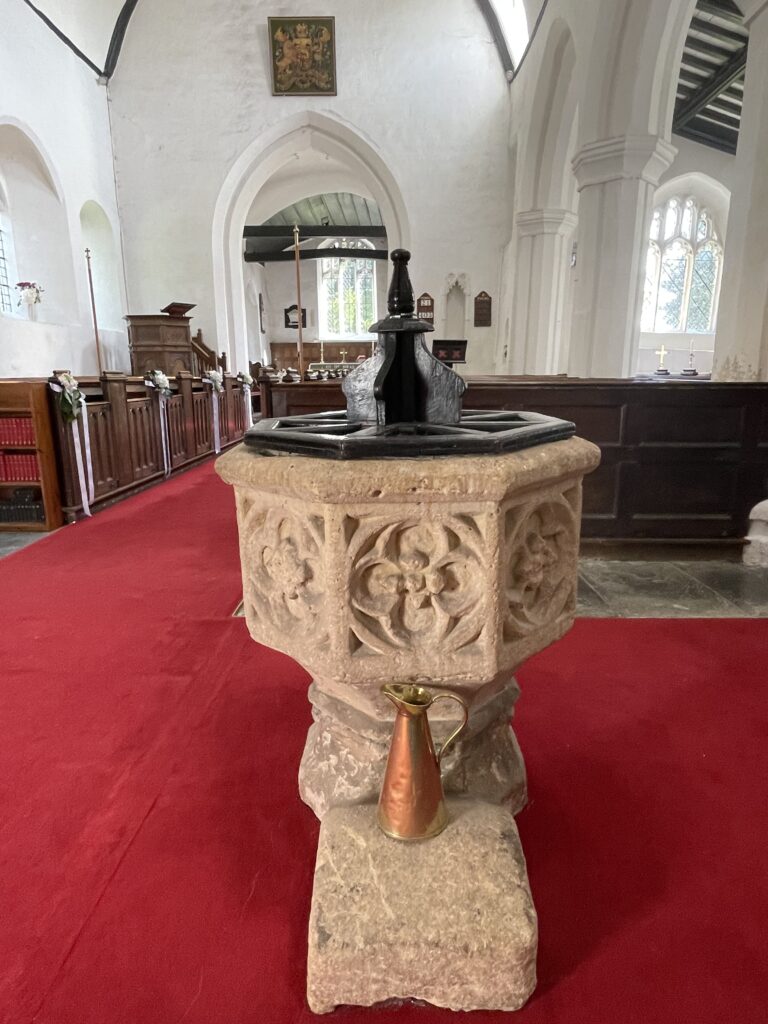
The Chancel
The Chancel dates back to the 13th century, and contains a piscina probably from the 14th century. The communion rails, probably 7th century originally had twice the number of balusters to prevent dogs from entering the sanctuary.
The east window above the Alter is a pleasing example of the perpendicular period, and at the apex, contains a small piece of medieval stained glass. The window is probably of the same period as the famous East window in Gloucester Cathedral commemorating the battle of Crecy.
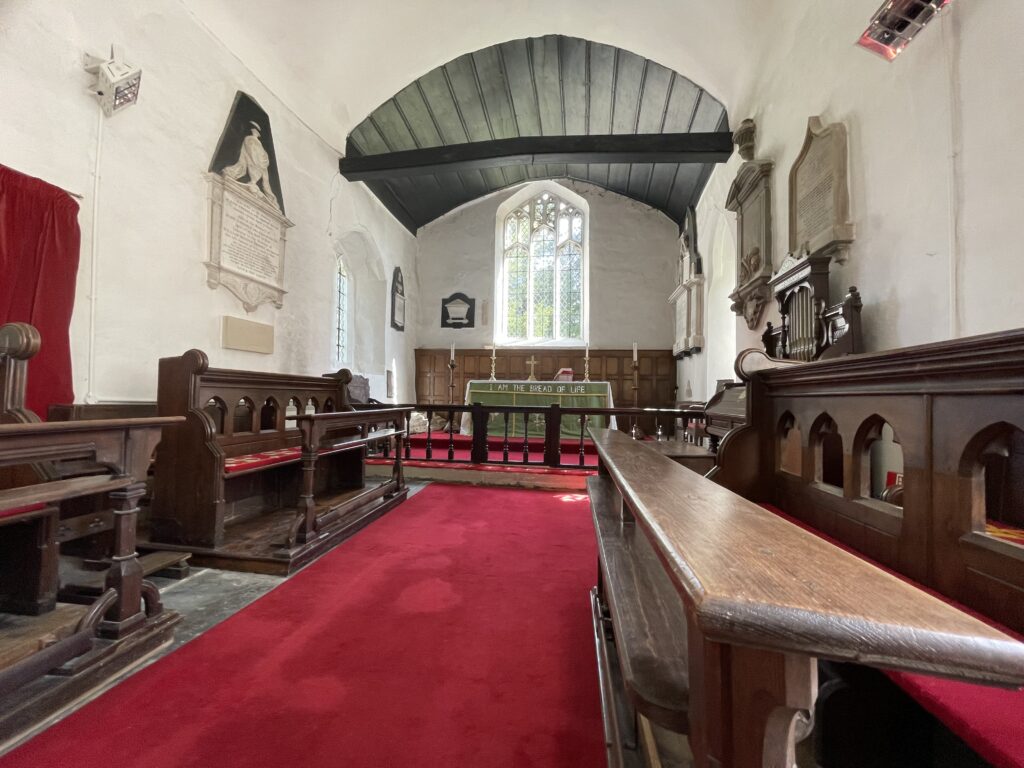
The Ancient Chalice
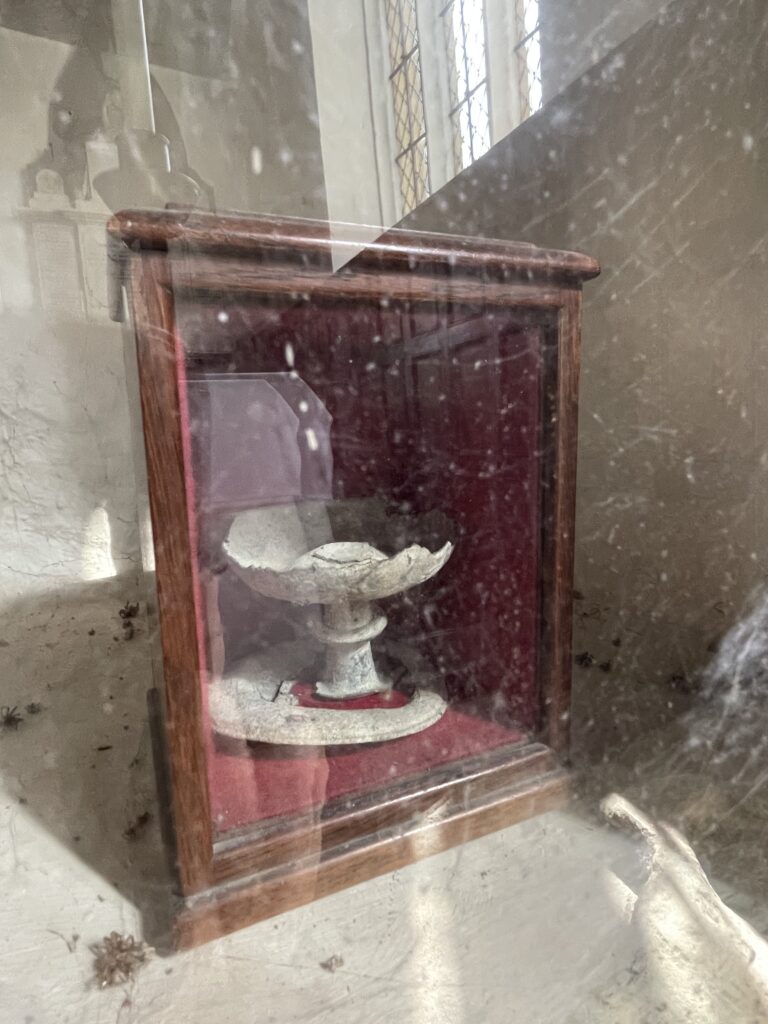
The ancient chalice pictures above, is dated 1331 and was unearthed from the grave of a former vicar, the Reverend Basel who was the incumbent of St Peter’s in 1450.
The Tower
The Tower of St Peter’s contains a clock with one dial facing East. The cook strike the hours, and was given by parishioners in memory of those who fell in the Great War 1914-1918.
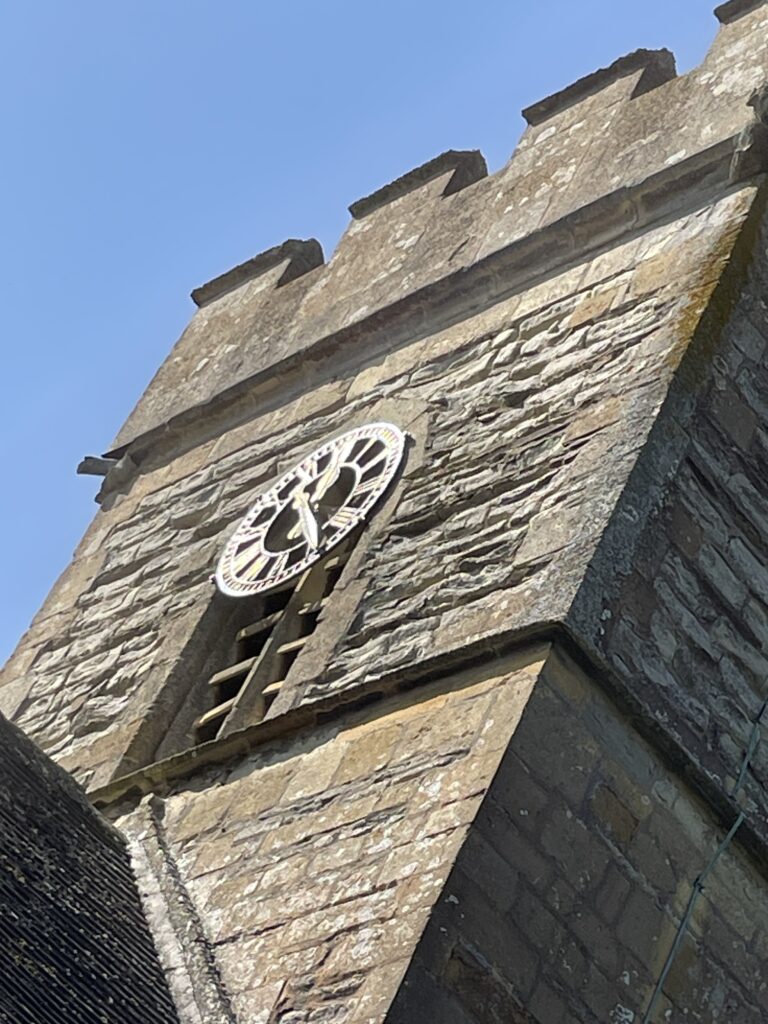
The 15th century Tower was built at the same time ad the Nave. There was originally a large window in the West end which was probably filled in after the collapse of the tracery.
There is a large arch connecting the Tower and Nave. The Tower contains a ring of five bells cast in 1707 by Evesham bell founder Michael bushell. Due to damage, the Tenor bell had to be recast. This was carried out by the bell founder Abraham Ruddall in 1732.
The Records of St Peter's
All down the ages the churchwardens of St Peter’s have kept very detailed, accurate and interesting accounts o church life, as well as accepting for church expenditure.
The ncint Vetry Minutes Books of this church have been the subject of praise by many historians. One expressed her delight by saying that “the books of Pebworth Church are dripping with historical riches”. Another well known lady said, that having read the books and records, made one feel really in tune with the hundreds of years they represent. She then added to this, “that to step through the door of this ancient building, was to walk into a treasure chest of good measure, well pressed down and running over”.
The waight of ye Belles as they came out of ye pitt
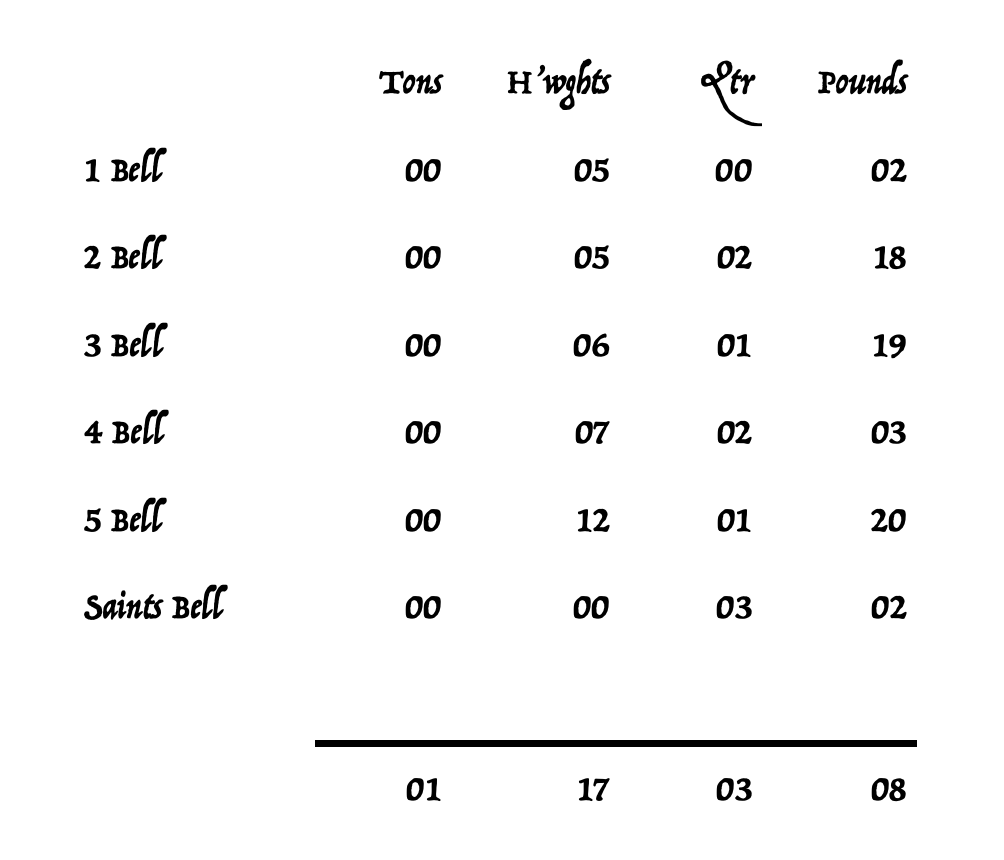
From parish records of 1707/8
The A Counts of Richard Lauler (?) and Ed. Williams Churchwardens for the yeare 1707
There are many items of interest in these ‘A Counts’, not least the spellings…. but perhaps a number of recurring items including the very last item – ‘Alle’ or ‘Ale’ – and more than 17 shillings worth across the project, reminds us that some things do not change…. Ringers do like a beer and the cost to the project was not insiginficant!
1707
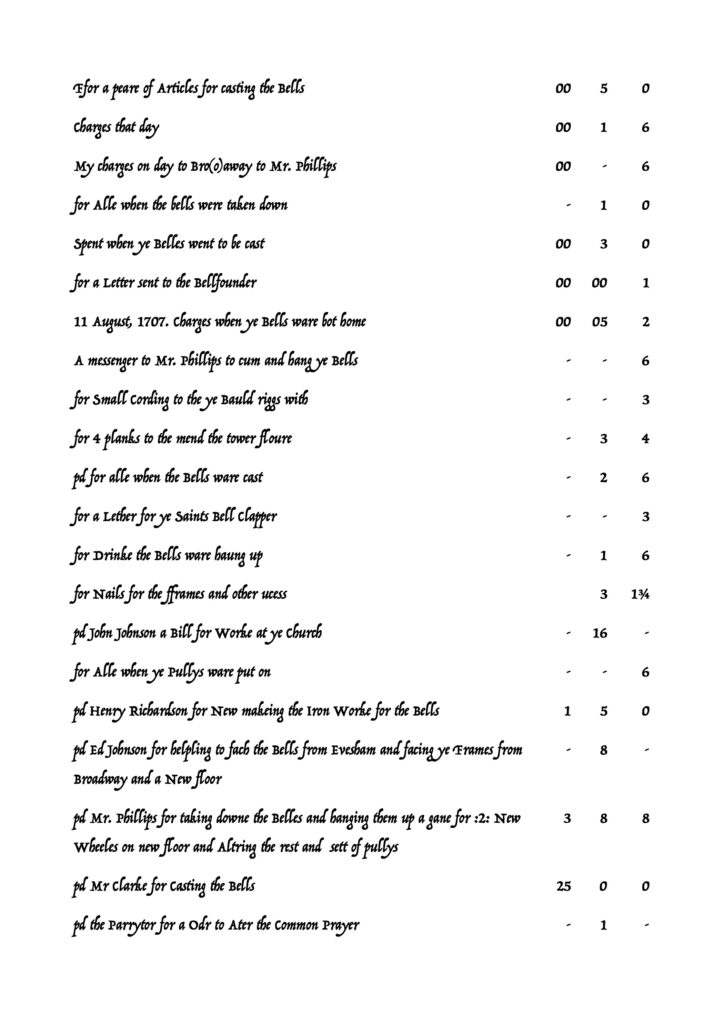
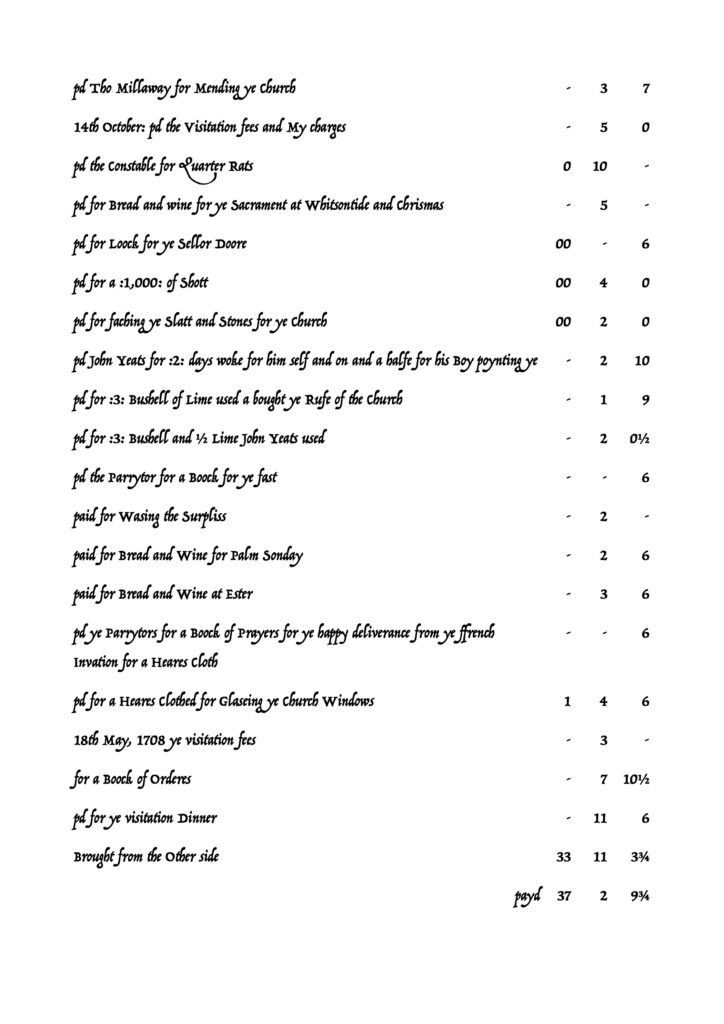
1708
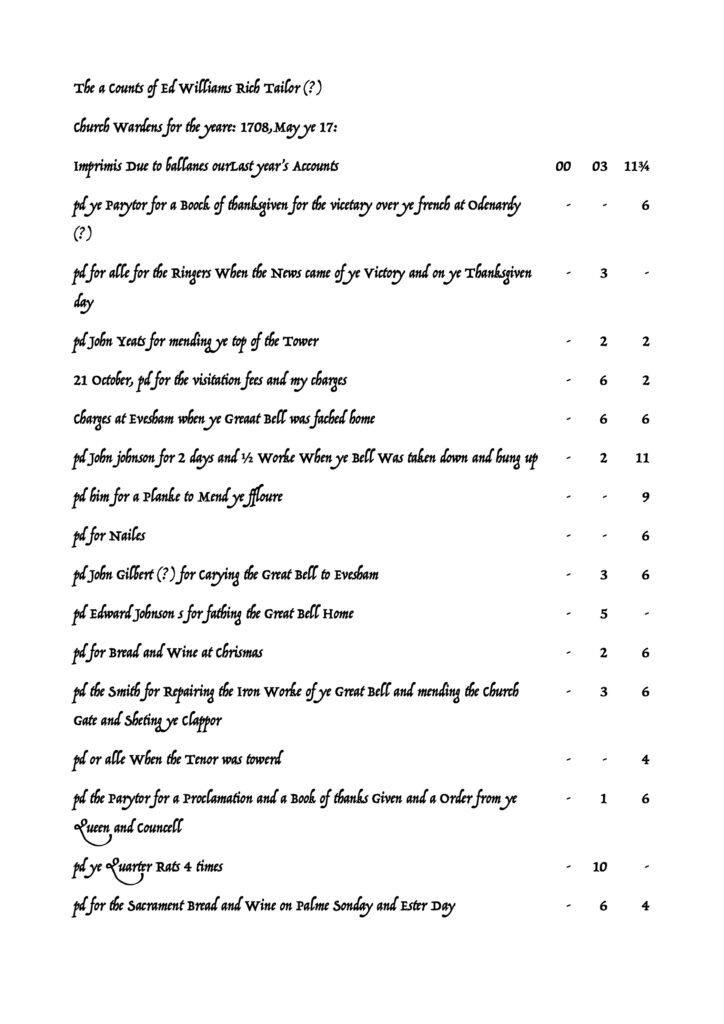
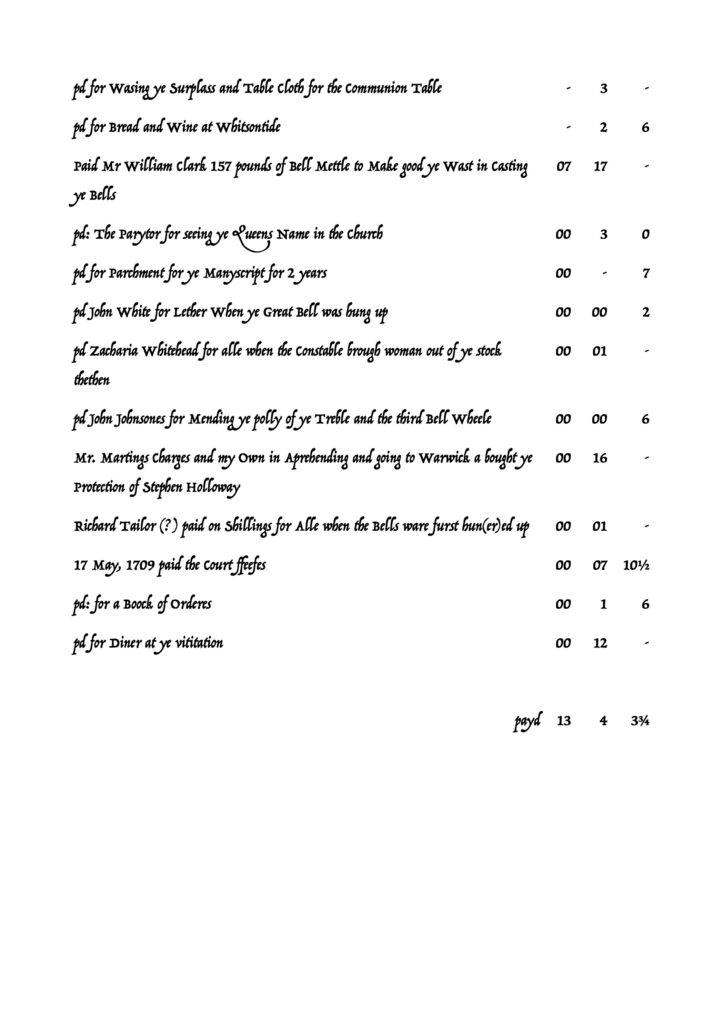
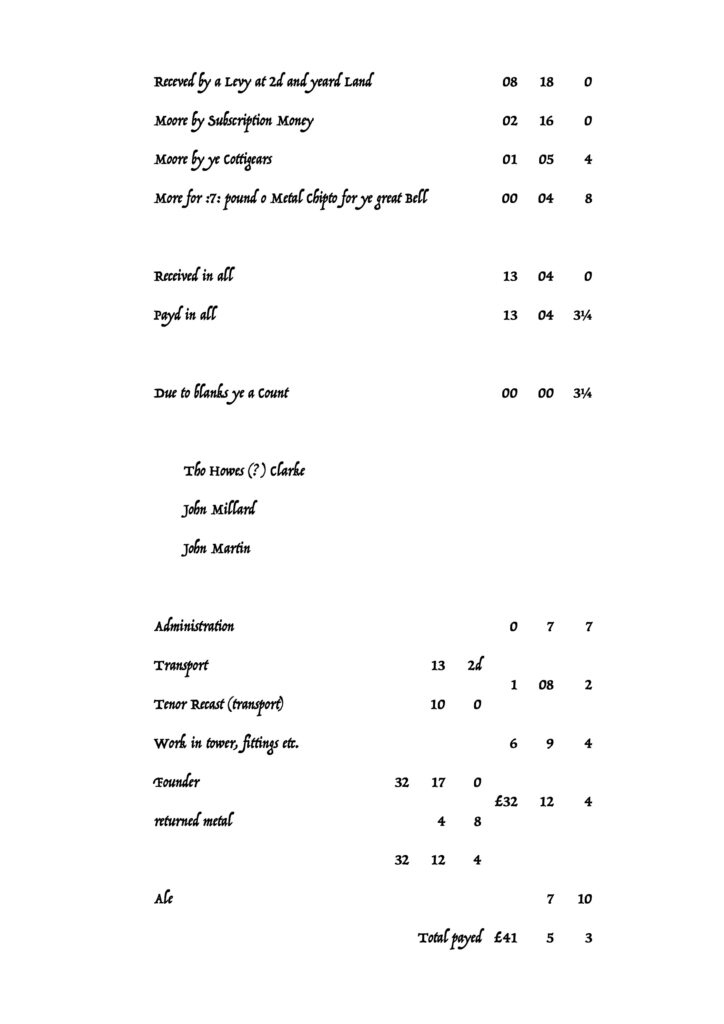
Craftsmen of Yesterday
It does well at this point to pause for a while and give a thought to those who have, over the years, rung and cared for the bells.
Every week over the many years, a band of ringers would turn up and the bells of Pebworth would ring out to call the faithful to worship.
In addition to this, there were obviously many times when works of repair and maintenance were called for. All this work would be carried out on a voluntary basis with the craftsmen of Pebworth taking an important role.
1938 Bell turned and Bell Clappers Modified
This work was carried out under the supervision of the village craftsman Mr. Frederick Mansell. Mr. Mansell, the Blacksmith and engineer in all metals was called upon to make improved “strap bolts” and other metal fittings. He also assisted in the actual turning of the bells to present unworn surfaces to the blows of the clappers. New weights and bushes for the clappers also came off the Man- sell drawing board” in an effort to make the bells sound better.
Our village blacksmith, whose work- shop was situated in Back Lane was a much loved person by all in the village. In addition to his great knowledge of horses, and his wide fame in that area, he was a great expert in “on the spot repairs” to household equipment.
Mr. Mansell obviously assisted in keeping day to day expenses down, by his great ability to bring about an expert repair to anything from a kettle to a horse plough.
The tower ladder (still in use today) is a very fine specimen of the work of Pebworth’s blacksmith.
Another village craftsman of great ability was Mr. Bert Emmes. The work shop of Pebworth’s Undertaker, Wheelwright and signwriter was situated near to the church.
Many fine works of carpentry and joinery were carried out at the church by Mr. Emmes.
He was very famous for the making of ladders and wheelbarrows, he made new head stocks for the bells, repairs to numerous items in the church, and one of his finest works is, without doubt, the Priest’s prayer desk in memory of the late Walter Tomlinson.
Unfortunately these craftsmen are of an age now gone. The works of their hands are still with us, they are there for us to treasure and to admire with pride.
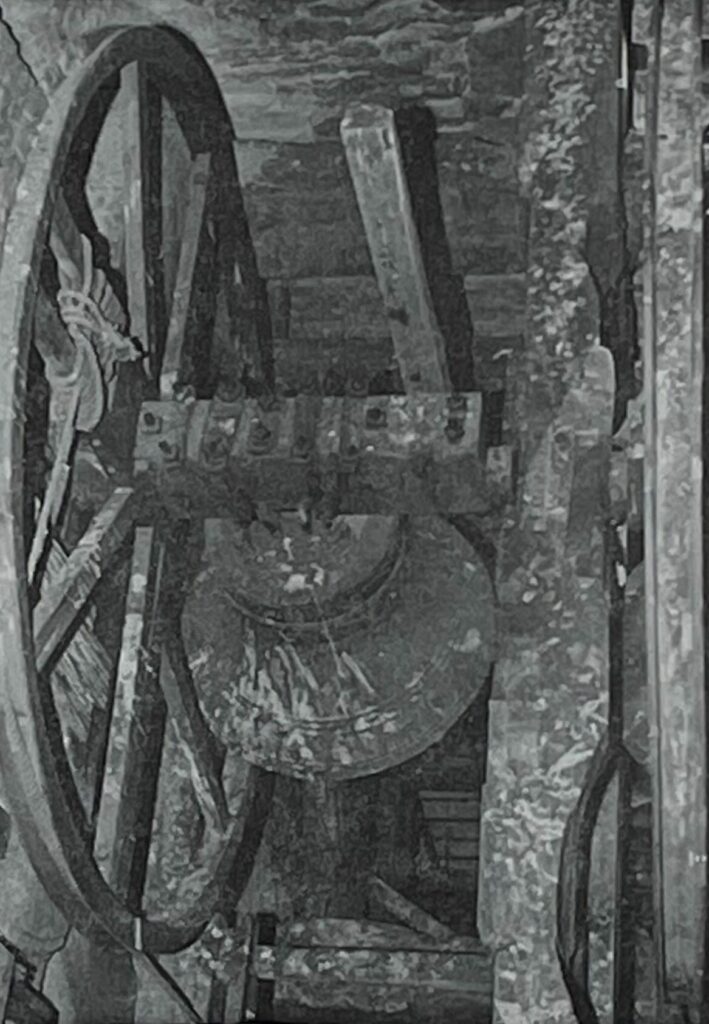
Engineers Report 1979
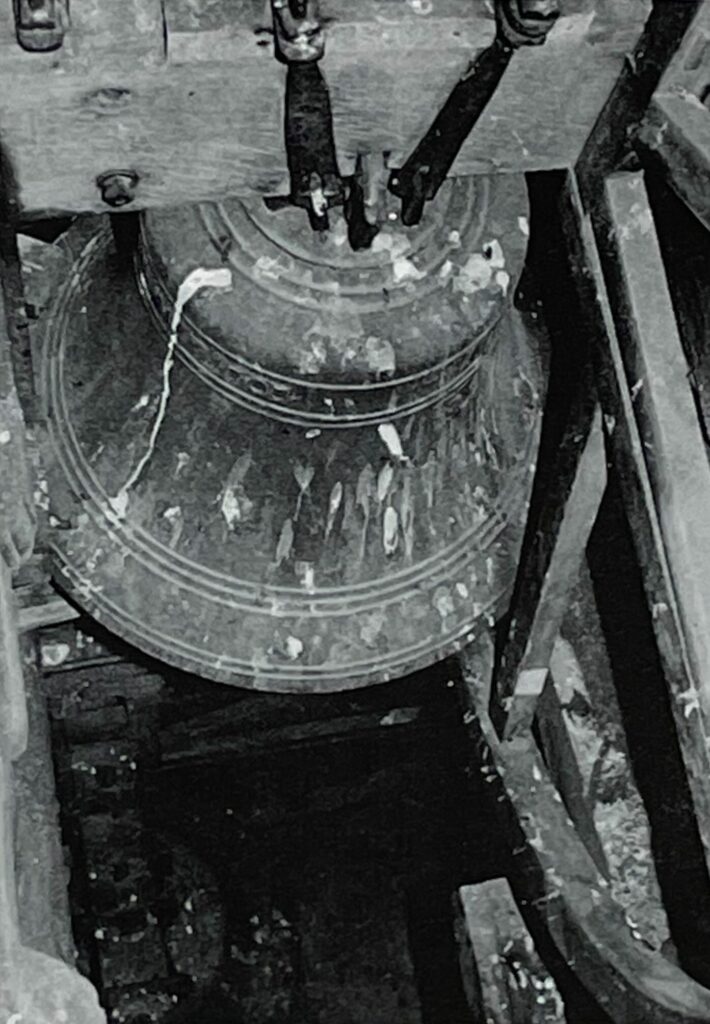
Overview
The West end Tower contains a ring of five bells, the inspection report, together with recommendations is as follows . ..
All five bells still retain their cannons (loops cast on at the time of founding to secure it to its mounting by means of strap bolts). Those of the third bell are damaged and one lug is broken off.
The bells also retain their original cast-in crown-staples. These staples of iron were cast into bell heads at the time of founding in order to suspend the clappers in the bells.
Cast-in staples are a frequent cause of bells becoming cracked, through the action ofthe iron in the bellmetal. These staples should be carefully removed from the heads of the bells and new staples of independent pattern provided.
There is considerable wear on the soundbows where the clappers have been striking. Some of the bells have been turned already to present unworn surfaces to the blows of the clappers, but all are again in need of turning.
Tonally, the bells are typical of their era in that they have peculiar harmonics. Careful monitored tuning on specialist machinery, would, however, bring them into a better relationship without spoiling the character of this ring of bells.
Unfortunately, there is a considerable piece of metal missing from the lip of the Treble bell, for some fifth of its diameter, and from 2″ – 3″ of its height. The effect of this section being missing is to reduce the resonance of the bell and to accentuate the fluctuating frequencies.
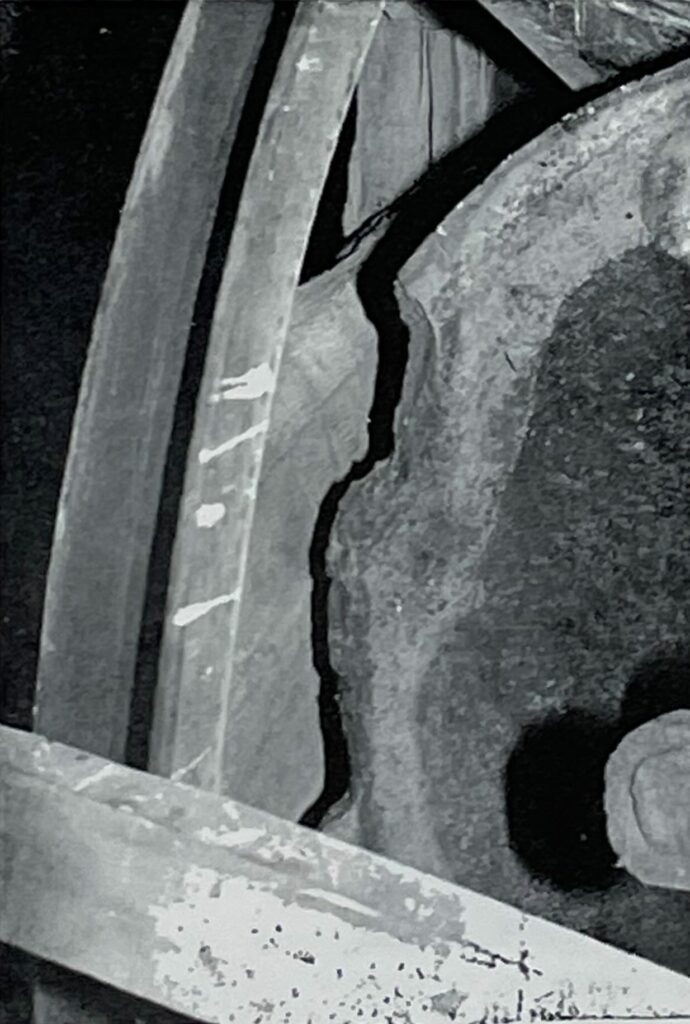
The photograph is of Pebworth’s existing Treble bell. The bell has been photographed from underneath so as to show the damaged soundbow.
It can be also seen from this angle, that the bell clapper is very worn. After being taken down from its frame, the bell will be welded in a special manner, so as to bring it back to its correct note.
The Bell Fittings
The bells are all mounted on plain type gunmetal bearings which are merely dovetailed into the headsills of the bellframe. All the bearings are much corroded and worn.
The clappers are very crudely wrought items, being greatly worn. The bell wheels are in a most dilapidated state due to rot and worm-attack.
The Bell Frame
Because of the confines of the Tower the bells are hung in two tiers. The two larger bells hang side by side in the base frame, and swing East to West. Bells nos. 1, 2 and 3 are hung in the upper tier, and are arranged to swing North to South.
The upper tier is carried by massive vertical posts in each corner from the base framework. Were it not for the confines of the Tower acting as a wedge, the upper tier would move alarmingly under the load of “live” bells. As it is, it cannot possibly be considered safe.
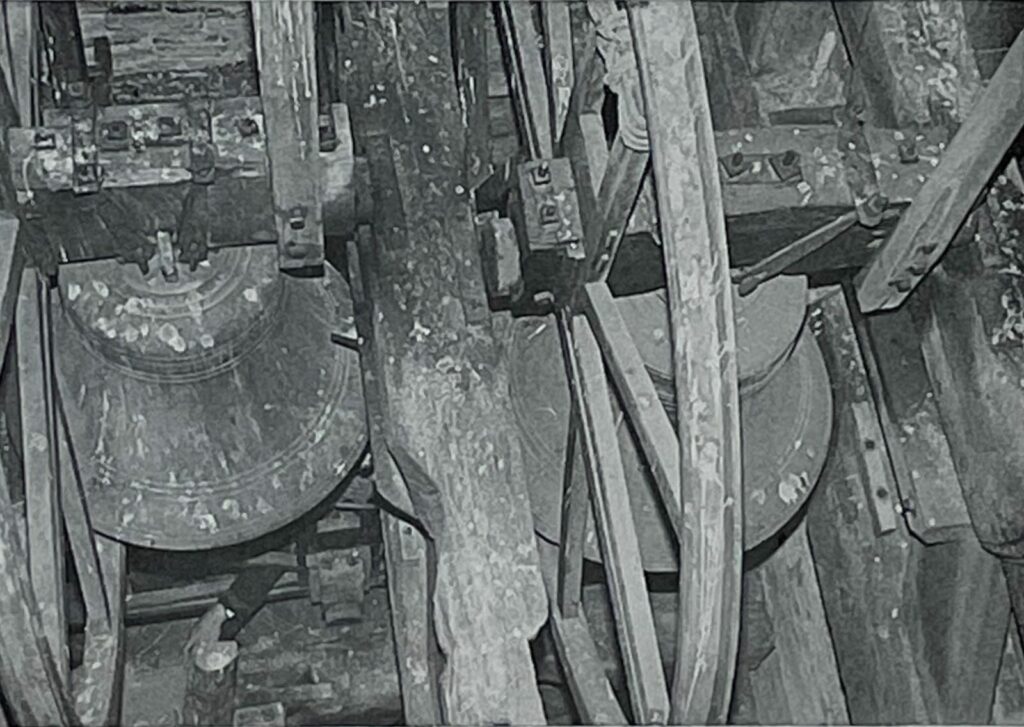
At various points the bellframe headsills have been cut back to allow the bell lips to clear whilst ringing. The Woodworking is excellent, with carefully decorated moulding. From the practical aspect, however, the effect is to weaken the frame further by removing large sections of load carrying timbers.
The Bells and their Maker
In 1984, Members for the Bushell family visit St Peter's
Until now, very little was known about the maker of the bells of Pebworth. The bell restoration committee, with the kind help of records office staff have, however, managed to put together a brief outline of his life and work.
The life and work of Michael Bushell has brought new interest and new visitors to the Parish Church of Pebworth. The “wheel of history” has turned a full circle and members of the Bushell family visit the church and sign the register.
“I want to climb up the Tower, and I want to touch the bells.”
Linda Bushell of South Littleton would not rest until she had been up the Tower, to see for herself the bells made by “Michael”
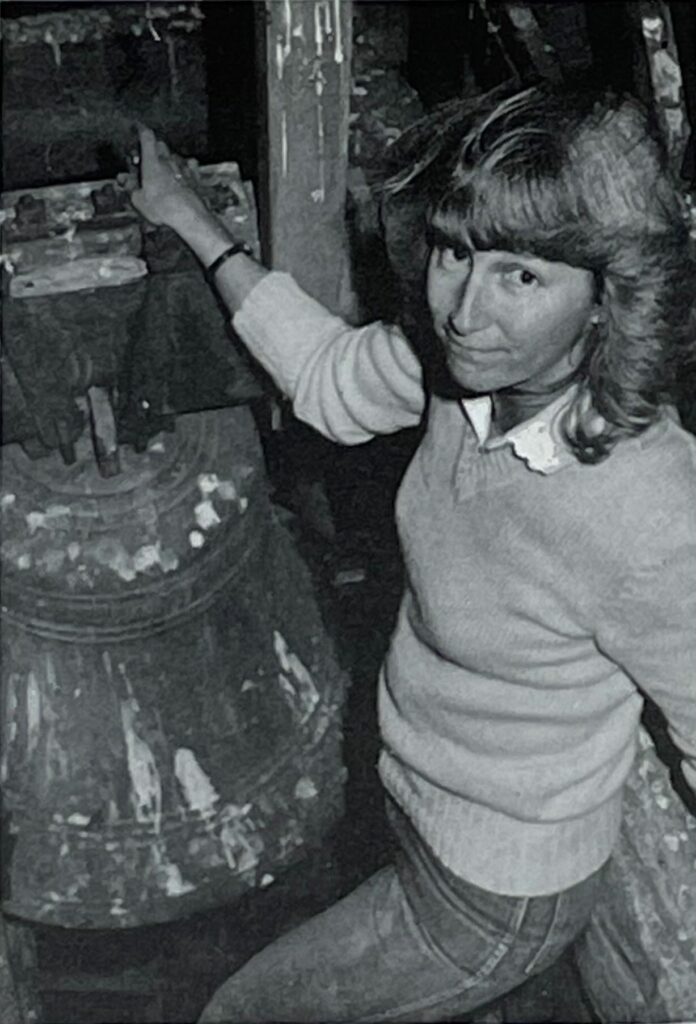
Linda sits among the bells, and that “glad I have seen it” look is captured as she admires the 2nd bell which is inscribed, “Michel Bvshell Mad Me 1707”
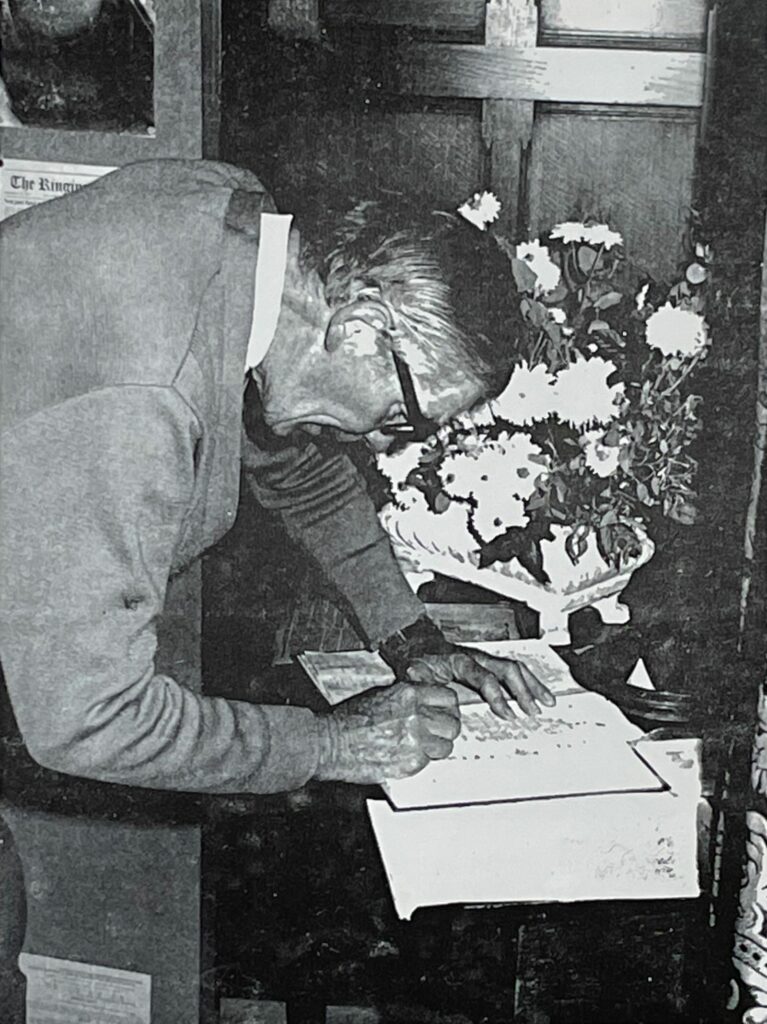
Mr Harry Bushell of Rickmansworth signs the church visitors record book.
As a result of the research carried out, living descendants of the Bushells of Broad Marston were found. Some were as far away as South Africa, other a little nearer in North Devon, Swindon and Hertfordshire.
After a lose of seven hundred years of forgot history, it is hoped that this visit and the unearthing of so many historical artefacts, will result in the locating of many other descendants of this famous Bushell family.
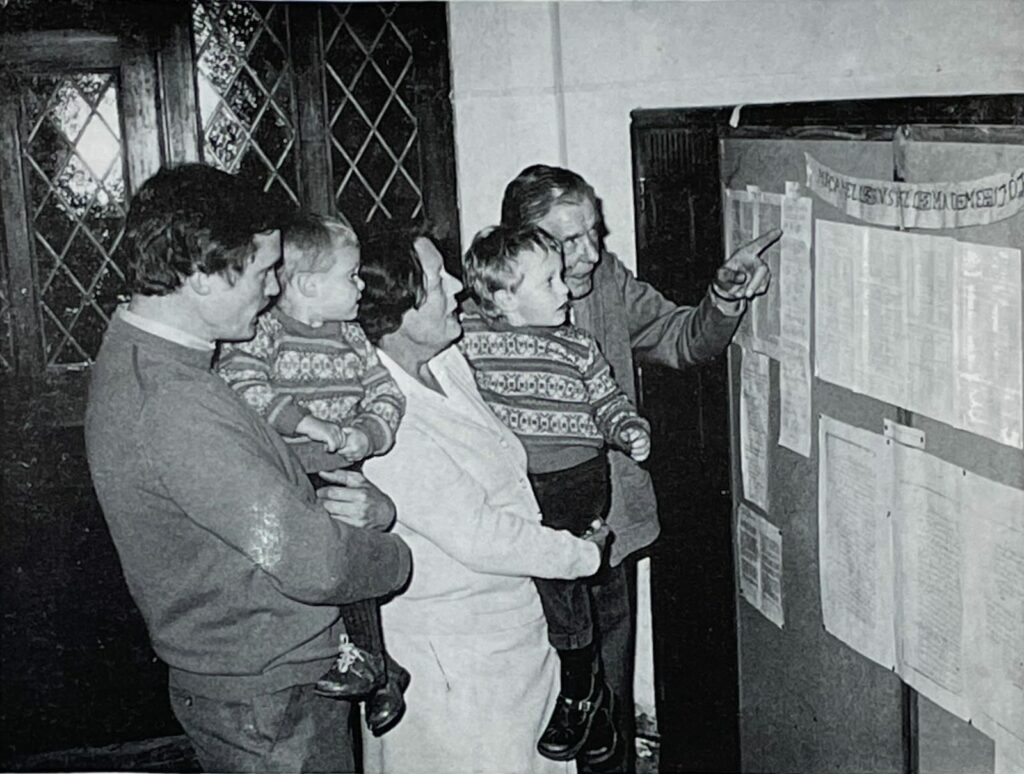
Great interest is shown in the Bushell family-tree. In the picture above the visitors pause for a while as Mr. Harry Bushell explains a particular point concerning Cecilia Bushell who lived at the Manor House in Cleve Prior. From the registers, Cecilia, daughter of Francis Sheldon. Buried, Cleve Prior, 7th October, 1716.
In mid-October, eight other members of the Bushell family visited the village and church. Among those who visited were, David Bushell and his wife Ann, with their children Matthew-Thomas and Richard-Allan, now living in South Malton in North Devon. Harry Bushell and his wife Margaret from Rickmansworth, Hertfordshire, and Elizabeth Carter (formerly Bushell). Elizabeth Carter (Bushell) who now lives in Capetown, South Africa, is the sister Roger Bushell who, during the Second World War, was killed by enemy forces in his bid for freedom during “The Great Escape”.
Accompanying the group of visiting Bushells were, Mrs. Elizabeth Newman, an historian from Cleve Prior, and Mr. Robert Massey, historian, archivist and associate of the Worshipful Company Grocers. Mr. Massey is also most keen to establish the enigma of the Bushell family. The visitors, continued from the church of St. Peter to Broad Marston Manor, to see for themselves the home of their Ancestors.
News that Pebworth was looking for a new treble bell, very soon reached the ears of the Rev. Peter Newing of Brimpsfield, near Gloucester. The Rev. Newing served for a while as Curate at Blockley, and being very interested in The Pebworth appeal, started a tireless search for the new bell. He eventually tracked it down in the small village of Cundle near Ripon in Yorkshire. This new bell, kindly parted with by the Rev. Peter Stirk, Rector of Cundle, will enable a “more balanced” ringing Peal once the refurbishment has been completed and the bells are returned and re-hung in a new metal frame.
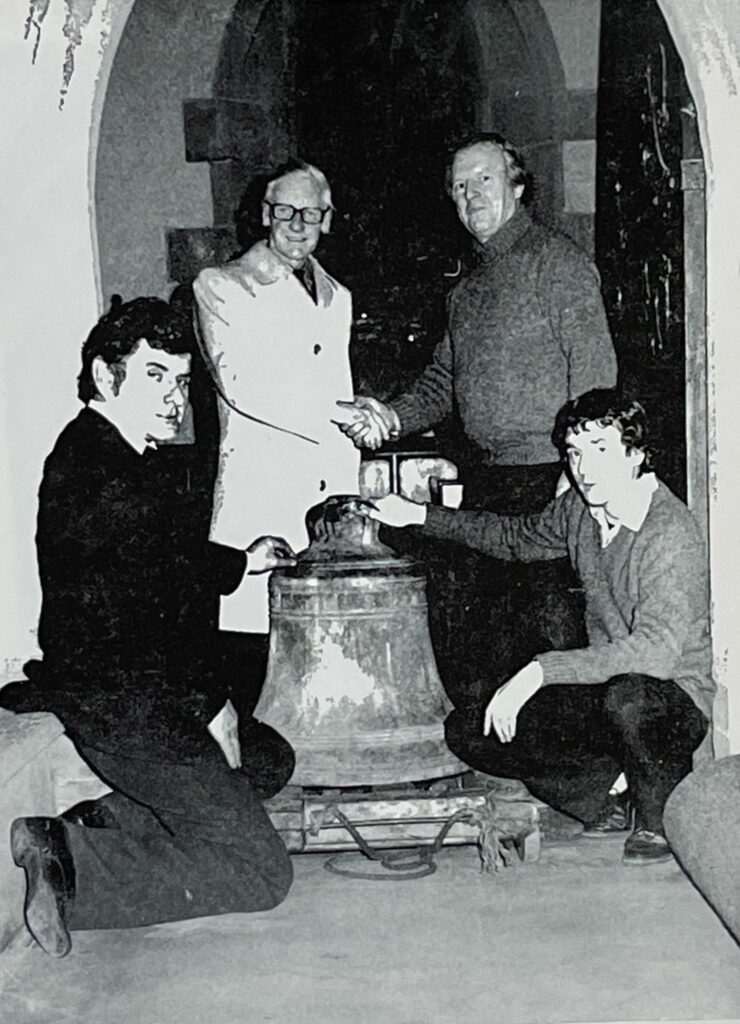
Pictured above, the much sought after additional bell is finally located in Cundle in Yorkshire. Gathered round the bell (from left to right) are, Mr. David Baker, Rev. Peter Stirk, Mr. Eric Jackson and Mr. Andrew Baker.
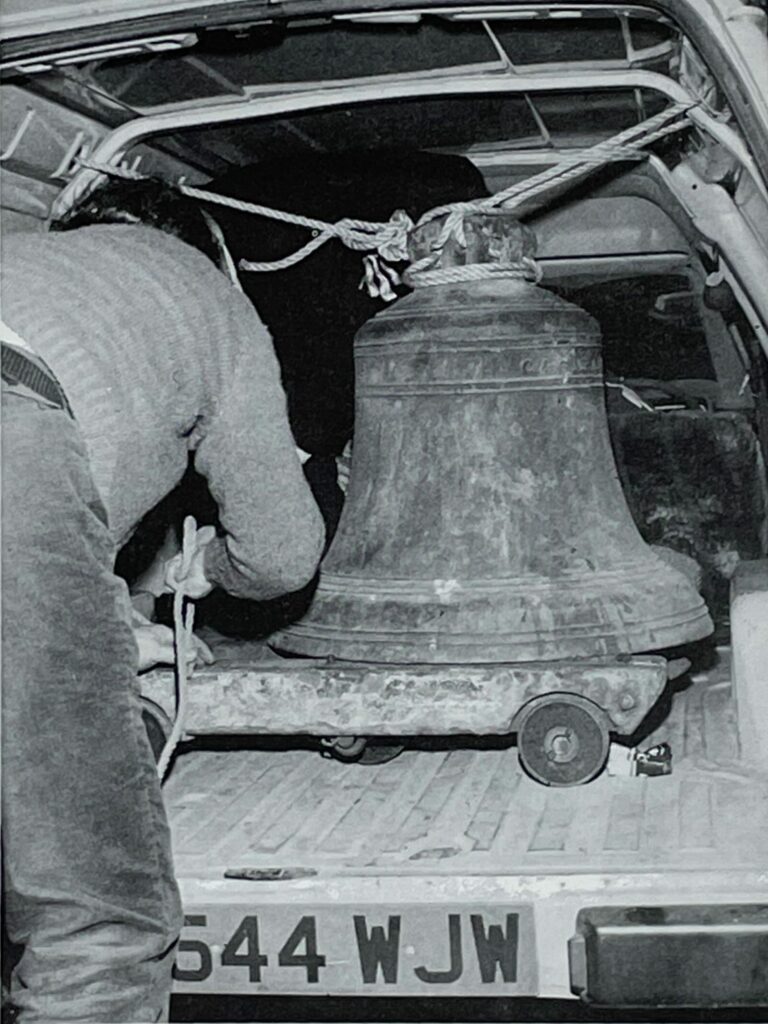
After its long journey from Yorkshire, Pebworth’s new treble bell arrives at the West gate of the churchyard. The bell weighs 45 cwt, is 2ft. in. in diameter, and will go to the foundry with the existing bells to be tuned in with them.
Throughout the restoration, the bell committee intend to make sure that the historical features of the bells are maintained. An additional aspect decided upon was the augmentation of the existing bells to provide a standard recognised peal of six.
The restoration committee have been expertly guided by Miss Mary Bliss, bell advisor to the Diocese of Gloucester, particularly as to the age and character of the new bell, so that it would blend in with the existing Peal and thereby giving a commendable result.
Michael Bushell - Bellfounder and Master Carpenter
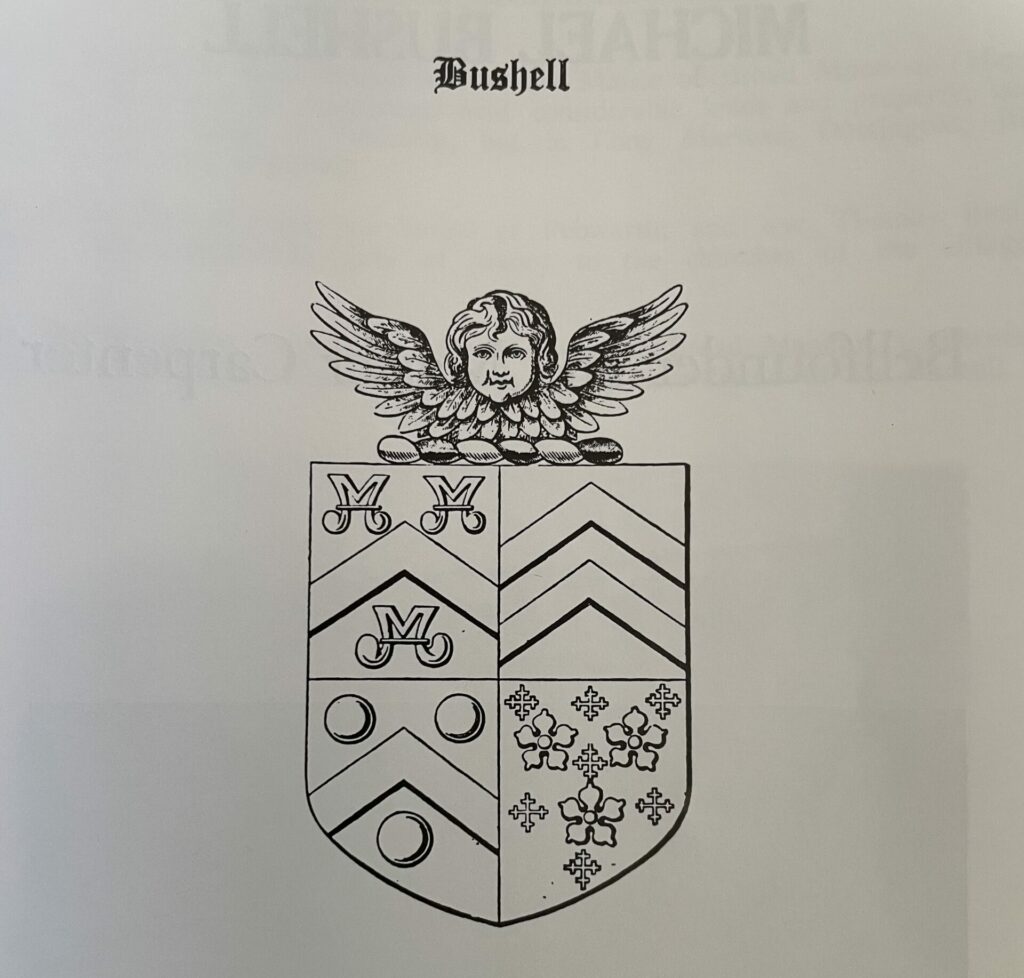
ARMS: Quarterly of four.
1 Argent, a chevron between three water bougetds sable; 2 Or, two chevrons azure; 3. Azure, a chevron or between there bezants; 4. Argent three cinquefoils between nine cross-crosslets gules.
CREST: A cherub’s head
In Search of Michael Bushell
In 1245, Knight Sir Alan Bushell was at the Manor of Broad Marston, (Hamlet of Pebworth). Sir Alan and his descendents held considerable lands and property, not only in and around the village of Pebworth, but in Long Marston, Dorsington, Bidford- on-Avon, and as far away as Brailes.
Many of the Bushell family are buried at Pebworth, and one Thomas Bushell of
Broadmarston left considerable sums of money to the churches of the villages just mentioned.
Many famous people visited the Manor House of Broad Marston, numerous visits were made by William Shakespeare who was a very close friend of the Bushell family.
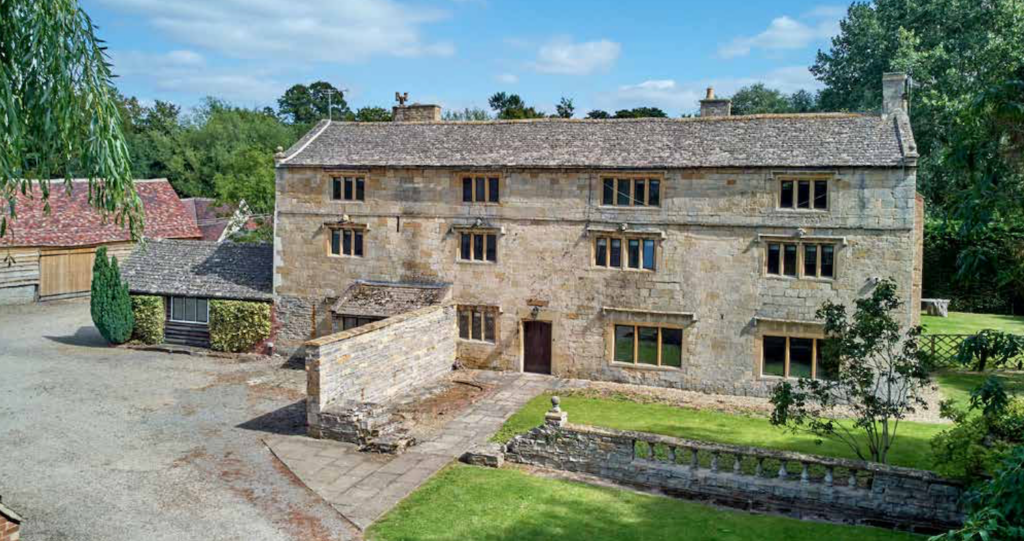
Broad Marston Manor. Home of Sir Alan Bushell in 1245. Many of the Bushell family have recently stayed here as guests of the present owners, Mr. and Mrs. A. W. Rochfort.
Another visitor to the house was a young local gentleman, Mr. Anthony Sadler (Entry in the Parish Registers.. Marriage, 1668, Sarah Bushell – Anthony Sadler). It is interesting to note, at this point, that the fourth bell in the Tower is to the memory of Richard Sadler, churchwarden. Richard was brother to Anthony.
The Bushell family spread out from Broad Marston, and many of them are laid to rest in the chancel of Cleve Prior Parish Church. The family were resident at Cleve for many years, and were particularly generous to the church and to the poor people of the village. From the Will of one Thomas Bushell of Cleve dated 16/4/1705 “I give to each of my servants the sum of ten pounds, and to the poor people of Cleeve Prior I give the sum of five pounds and five shillings.
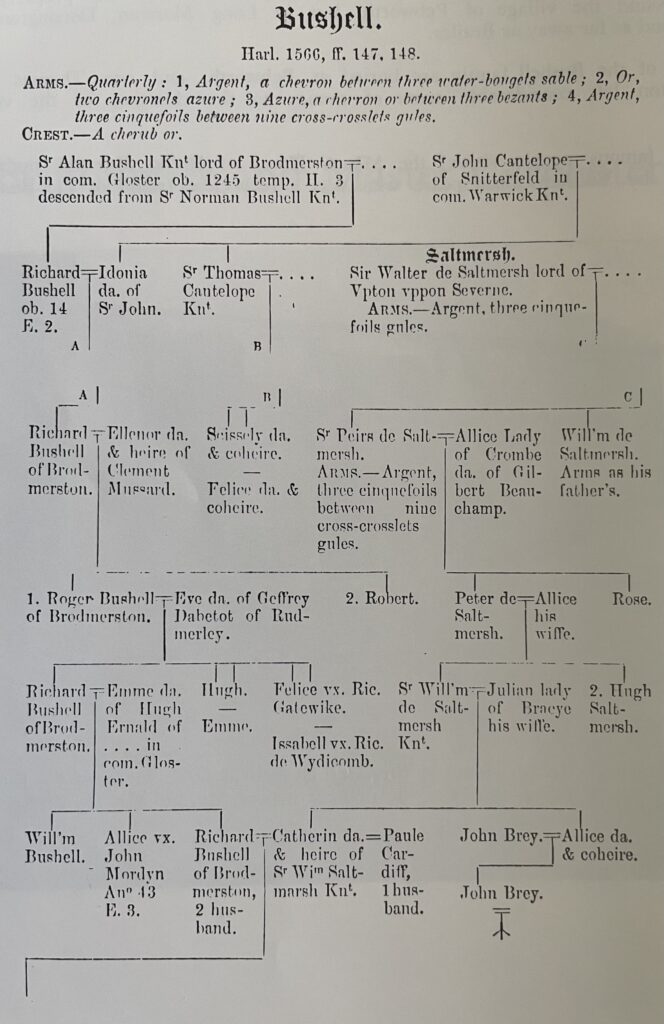
From the Last Will and Testament of one Edward Bushell of Cleve Prior, dated 11/ 12/1545… “I bequeath my soul to Almighty God, and my body to be buried in the Parish Church at Pebworth in such a place as it shall please my Father. I bequeath to the Parish Church of Pebworth the sum of VIs – VIIId.”
Over the years, as with all families, the Bushells married and moved to various places. For instance, some moved to the Littletons, some of the family moved to the town of Evesham. Many entries of Bushell Births, Deaths, and Marriages are to be found in the registers of Bengeworth and St. Lawrence.
At the time of Thomas and Cecilia Bushell being at Cleve, we also find records of Bushells being at the little village of Fladbury, nr. Evesham.
It is here, at last, in the Vale of Evesham, with its stalwart Bell Tower, remains of its once magnificent Abbey Church, and all the rich historical accounts of Simon-de-Montfort that we find the records of the Birth and Death of Michael Bushell.
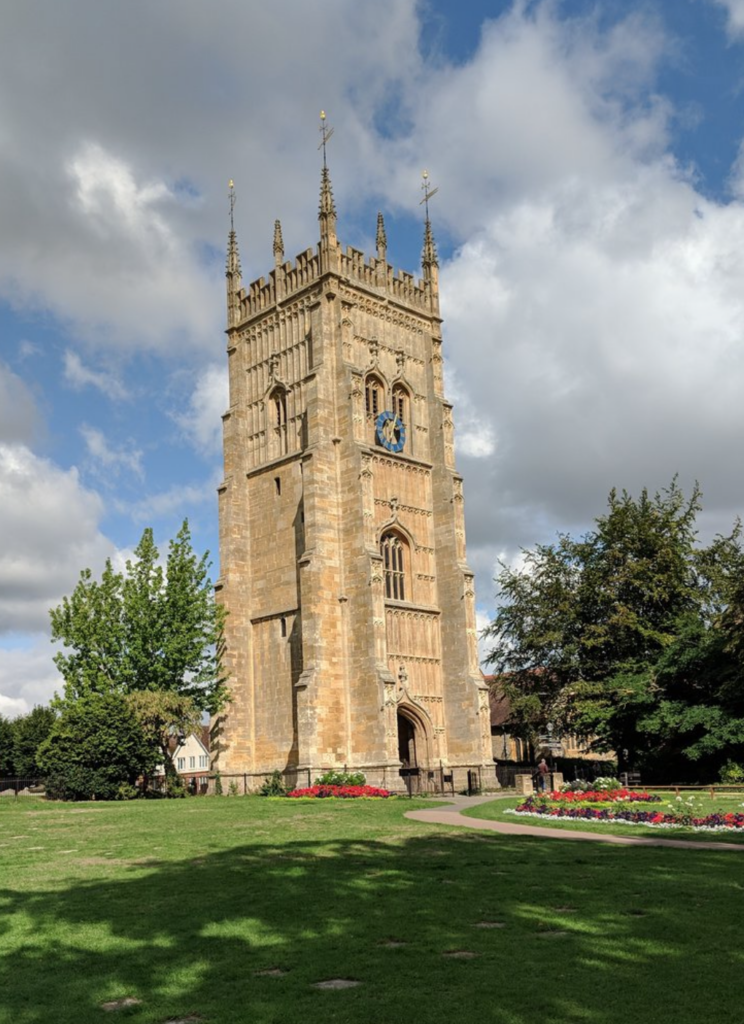
Evesham’ famous Bell Tower
Michael Bushell set up his bell foundry in Evesham, in partnership with a close friend, William Clarke. The foundry was situated on Merstow Green, and was previously owned by Richard Bagley, himself being a member of a very well known family of church bell makers.
Merstow Green Evesham. Site of the Bushell foundry in 1707
William Clarke had worked previously for a bell founder in Bromsgrove, as foreman, so he obviously had a good working knowledge and experience in this field. It is assumed that the partnership was helped by family friendship (Entry . . Parish Register . . Bengeworth Evesham .. Marriage . . Sarah Clarke. . Richard Bushell).
Bells cast by the Bushell foundry bear the mark I.H.S. and, of course, the founders name. The treble bell at Pebworth has the following inscription on it “Sanctus en Nomine Patris, et Filius et Sprit Amen”, Unfortunately there are very few bells by Bushell left, today. There were many in the Evesham and Stratford areas, but they have, for various reasons, been re-cast.
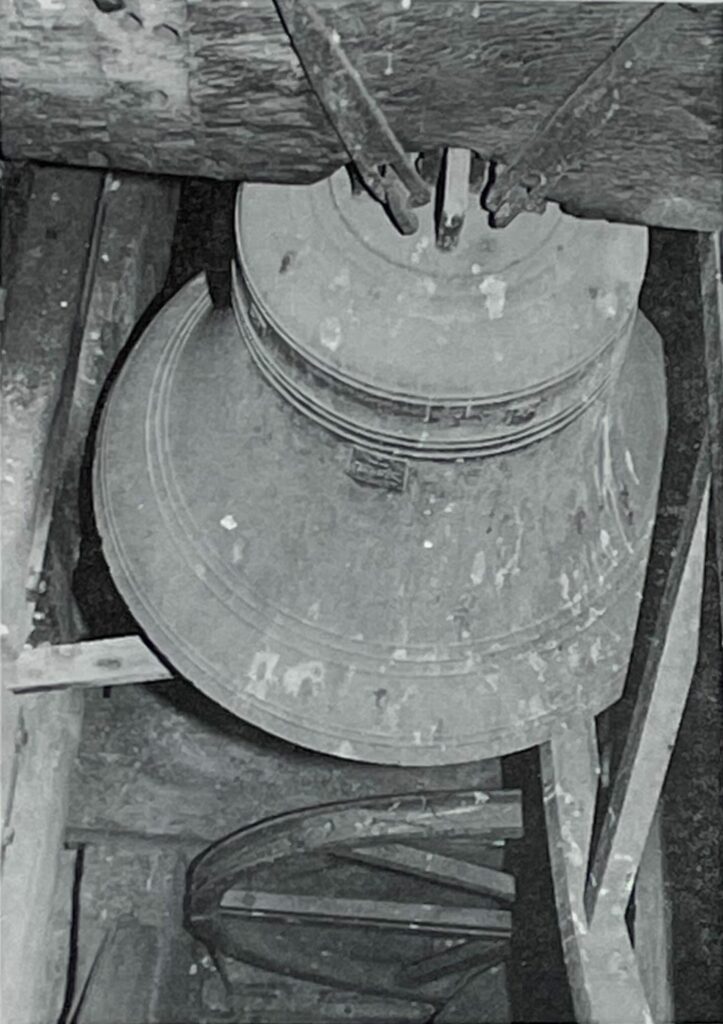
Pictured on the left is Pebworth’s 3rd bell. Note the inscription mark ✝ I.H.S.
Note also that as with all the other Pebworth bells, the “Cannons” of the bell are still intact.
We are therefore, very fortunate to have four specimens of his work in the Tower at Pebworth. Other bells in existence are:-
- a ring of four at Newbold Pacey in Warwickshire
- bells 2 and 5 at Henley-in-Arden
- one bell at Hinton on the Green
- one bell at Watcote.
In the church records of Badsey, nr. Evesham we read, “The Great bell of Badsey installed by Michael Bushell”
There are also records of a Bushell Bell being installed at the church in Beoley, Worcestershire
In 1707, the Bushell Foundry at Evesham was very busy, the order books were full, for Michael Bushell was not only a founder of bells, but a “Master Carpenter” also. Both these talents were obviously in great demand by the Church as well as by the community as a whole.
Like all bell founders, Bushell and Clarke were at the centre of the local bell ringing
scene, and it was in the churchyard of St. Lawrence Evesham, near to the place where he had spent so many hours, both as maker and ringer of bells that Michael Bushell was laid to rest in 1726.
Like many other craftsmen before him, Michael Bushell has left his mark, and the works of his hands have become part of our English Heritage, to be enjoyed forever.
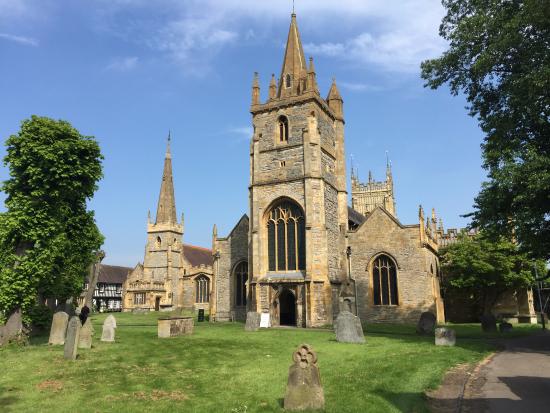
Church of St. Lawrence, Evesham. Last resting place of Michael Bushell.
That which was broken shall be made whole...
The P.C.C. and the Bell Restoration Committee thank you for supporting the bell appeal. We hope that you have enjoyed this book which was sold in aid of the funds.
On this last page, we conclude with a last reference to Pebworths’ broken bell. The inscription can be seen in part on the photograph, it reads in full, SANCTUS EN NOMIN PATRIS ET FILIUS ET SPRIT AMEN”. This bell must surely remind us that as church members our own responsibilities and purpose should be the Glory of the Holy Trinity.
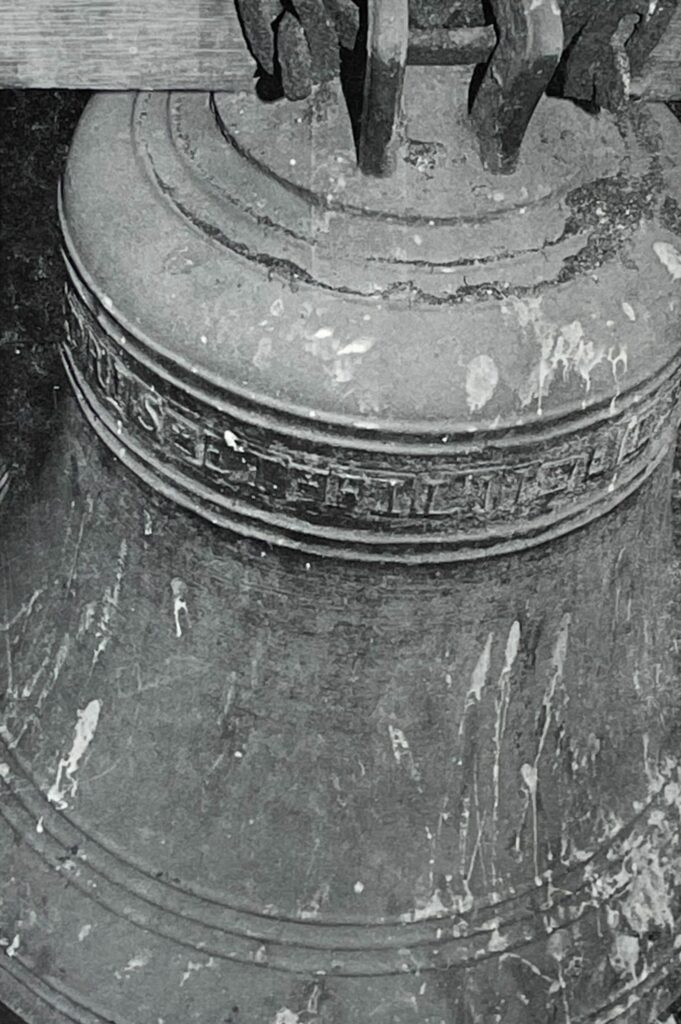
“The Bell Will Ring Again”
The Appeal Leaflet
A copy (rather crumpled after nearly 40 years) of the original appeal leaflet.
